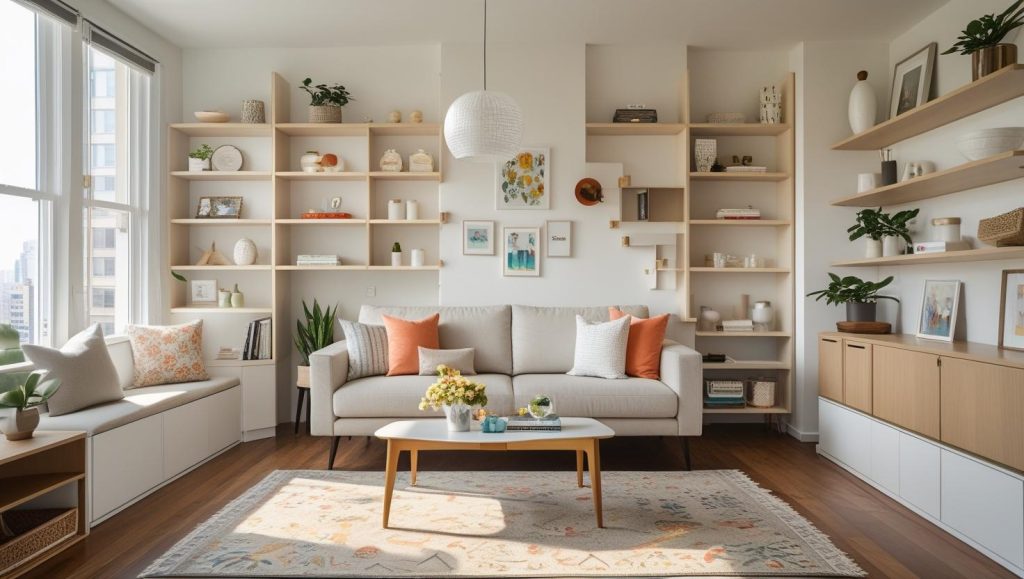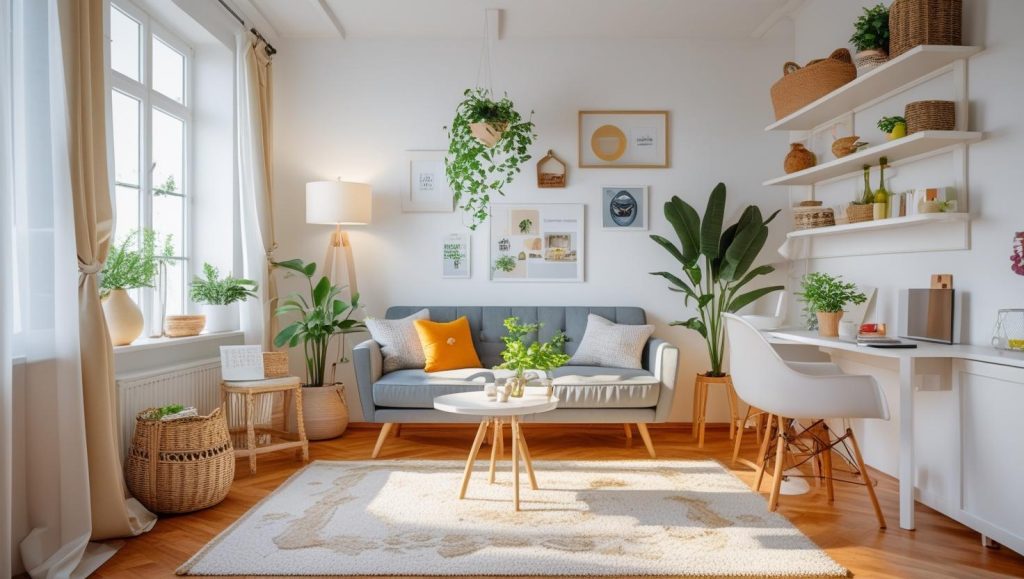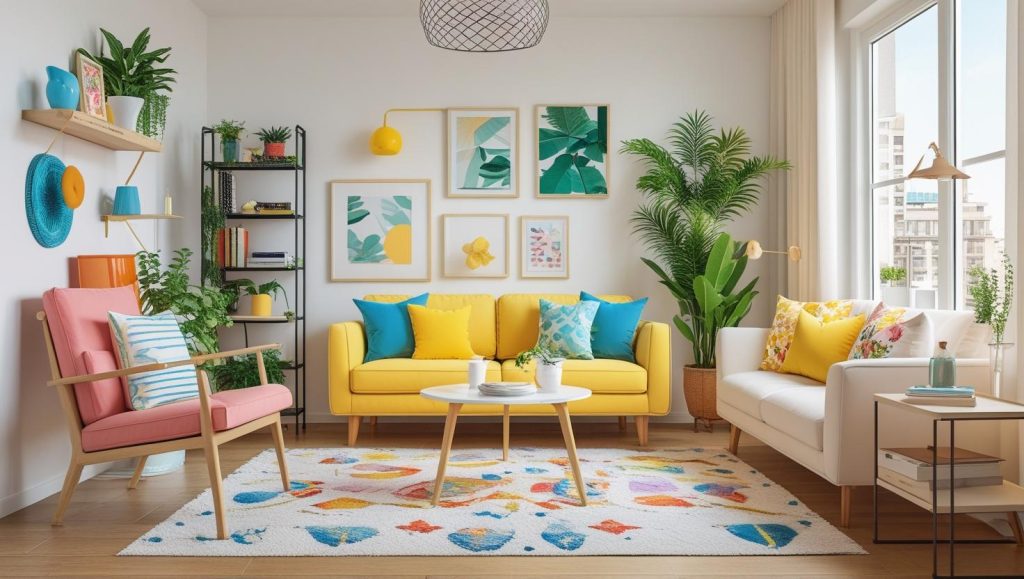Let’s be honest—living in a small space can be frustrating. Whether you’re in a tiny apartment, a compact home, or just dealing with a few tight rooms, it often feels like you’re one step away from clutter and chaos. But here’s the good news: you don’t need a massive square footage to live beautifully. With the right decorating hacks, you can transform even the tiniest corner into a functional and fabulous area.
This blog post isn’t just about making a space look good; it’s about making it work harder and smarter for you. From furniture that multitasks to wall tricks that open up a room, these 17 genius decor hacks are designed to help you create more space, more style, and more comfort—without the overwhelm.

If you’re tired of tripping over furniture or feeling boxed in by your layout, keep reading. These ideas are real-life tested, renter-friendly, budget-conscious, and above all—stylish and smart.
1. Use Light Colors to Open Up the Room
Dark colors can make a small room feel smaller. Stick with light, airy shades like whites, creams, soft greys, and pastels. These colors reflect light and create the illusion of openness, making your space feel bigger and brighter instantly.
If you still crave a touch of boldness, use deeper tones as accents—think pillows, throws, or small accessories. This way, you get depth without sacrificing visual space.
2. Embrace Vertical Storage
In small spaces, floor space is premium—so go up! Install tall shelves, wall-mounted cabinets, or floating racks to store books, décor items, and essentials. Vertical storage draws the eyes upward, adding height to the room and clearing out unnecessary floor clutter.
Even a simple vertical organizer in your bathroom or kitchen can work wonders. It keeps things off countertops and gives everything a home.
3. Choose Multi-Functional Furniture
Furniture that does more than one job is your best friend. Think ottomans with storage inside, sofa beds, fold-out desks, and coffee tables with drawers or shelves underneath.
These pieces help reduce the number of items in your space without sacrificing comfort or style. It’s about being intentional with every item you allow into your home.

4. Use Mirrors to Create an Illusion of Space
Mirrors reflect light and surroundings, making rooms appear much larger than they are. Placing a large mirror opposite a window or behind a light source can dramatically enhance the brightness and depth of a room.
Even mirrored furniture or decorative elements, such as trays or frames, can add that same magic. It’s one of the oldest tricks in the design book—and it always works.
5. Go for Open Shelving
Closed cabinets can make a room feel boxy and heavy. Open shelves, on the other hand, create visual breathing space. They’re perfect for displaying beautiful dishes, books, baskets, or plants.
Just make sure to style them neatly—too much clutter can ruin the effect. Group similar items together and leave some space in between to keep it airy.
6. Use Curtains Strategically
Hang your curtains high and wide—even beyond the window frame. This makes the window appear larger and the ceilings higher, giving your room a grander feel.
Also, choose light, sheer fabrics that allow natural light to flow in. Natural light makes every space feel fresher and more spacious.
7. Float the Furniture
Pulling furniture slightly away from the walls can make a room feel less cramped. It may seem counterintuitive, but that small gap creates the illusion of space and gives a more thoughtfully designed feel.
Try floating your sofa or accent chair and placing a slim console or shelf behind it. It adds storage without blocking the flow.
8. Incorporate Hidden Storage
Look for opportunities to hide storage in plain sight—under-bed drawers, built-in seating with compartments, or stair-step storage solutions if you live in a multi-level space.
This is especially helpful in studio apartments or small bedrooms where traditional storage options are limited.

9. Choose Clear or Lucite Furniture
Transparent furniture, like acrylic or glass pieces, takes up visual space without making the room feel crowded. A clear coffee table or chair lets the eye travel through it, helping the space feel open.
They’re modern, chic, and barely-there—but still totally functional.
10. Use Rugs to Define Zones
Rugs help you visually separate spaces—especially in open layouts. Use a rug to define your seating area, dining corner, or even a reading nook.
This helps create structure and order, making small spaces feel more intentional and less like a catch-all.
11. Hang Wall-Mounted Lights
Ditch bulky floor lamps and table lamps. Wall-mounted sconces or hanging pendant lights free up precious surface space while still providing stylish lighting.
They also add vertical interest and make the walls feel more involved in the design.
12. Keep Decor Minimal and Meaningful
In a small space, less is always more. Choose a few meaningful decor pieces rather than overloading shelves with random trinkets.
Edit regularly. Keep what you love and let go of what doesn’t add value or joy to your space.
13. Use Foldable or Stackable Pieces
From dining chairs to desks and laundry baskets, foldable or stackable pieces are great for maximizing space. Pull them out when needed, and tuck them away when not.
They’re especially perfect for homes that host guests occasionally but can’t afford permanent furniture clutter.
14. Make Use of Corners
Corners are often ignored, but they’re perfect for storage or decor. Add a corner shelf, a tall plant, a floor lamp, or even a cozy reading chair.
These often-forgotten spots can become functional and beautiful areas when styled with intention.
15. Choose Slim Furniture Designs
Go for slim-profile furniture rather than bulky furniture. For example, pick a sleek desk with thin legs over a chunky one, or a sofa with raised legs instead of one that sits flat on the floor.
Slim pieces open up the room visually and physically—every inch counts in a small space.

16. Hang Art High
Positioning art higher than eye level makes ceilings appear taller. This simple trick can make your room feel more expansive.
Even a gallery wall placed slightly above your typical eye line can add drama and vertical dimension to a tight wall.
17. Opt for Sliding Doors
If possible, swap out traditional swing doors for sliding or pocket doors. They take up far less space and open up the floor area near doorways.
This is particularly helpful for closets, bathrooms, or small bedrooms where every square foot matters.
Conclusion
You don’t need a bigger house to live large—you just need smarter design. These 17 genius decor hacks for small spaces prove that a little creativity goes a long way. Whether you’re decorating a tiny apartment, making over your bedroom, or simply looking for ways to make your space work harder, these ideas offer both style and function.
Remember, small doesn’t mean limiting—it means intentional. Every piece, every color, every layout choice should support the way you live and feel in your home. Start with one or two hacks and build from there. Soon enough, you’ll be living in a space that feels bigger, brighter, and more you.
So go ahead—reclaim your space, one genius idea at a time.
